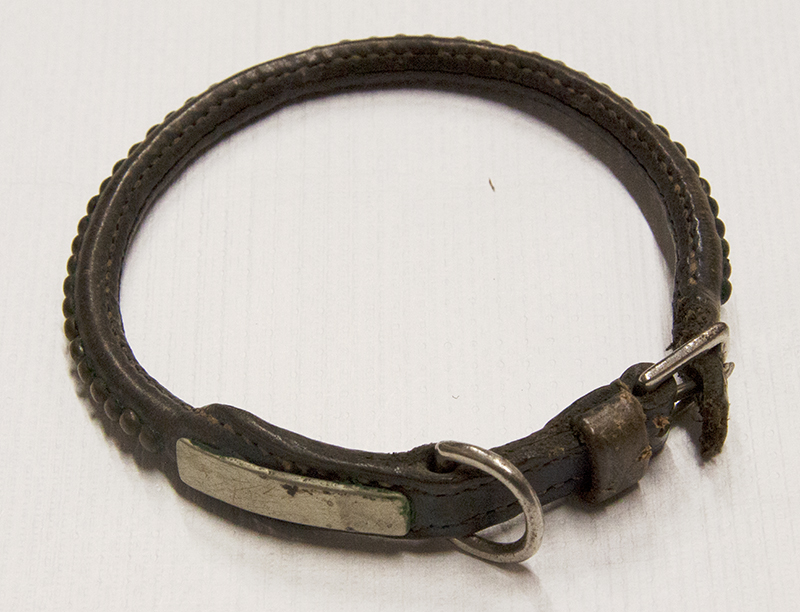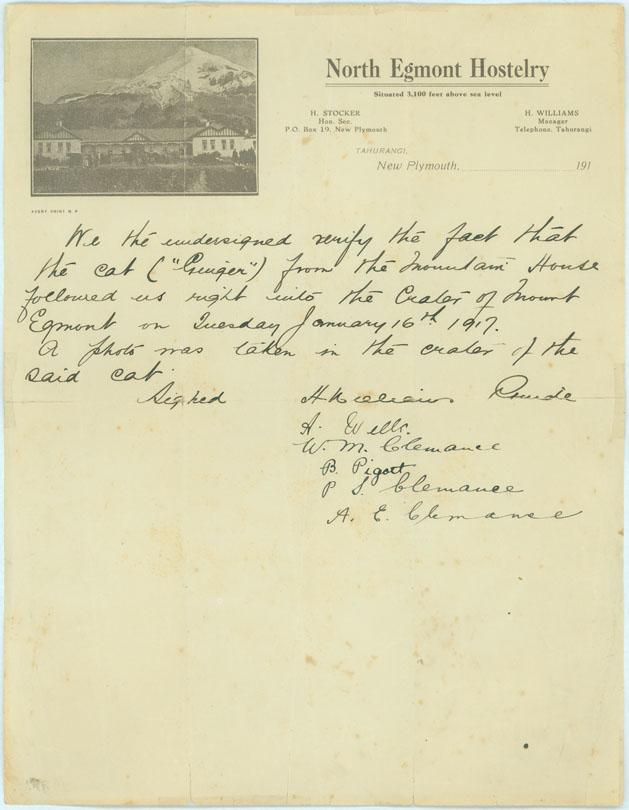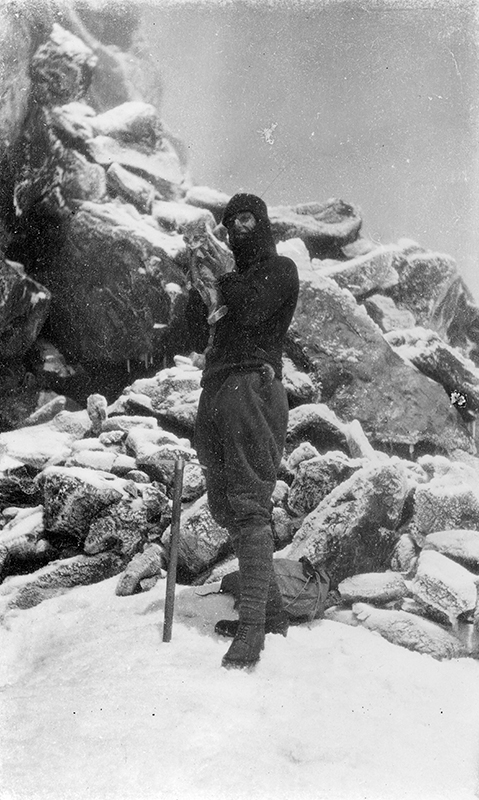



There have been a number of celebrity felines that have caught the imagination of the public and media, inspiring their own headlines, making television appearances, starring on posters, reaching great heights and earning themselves emotional send-offs.
Possibly the most famous cat of all was biker Rastus, who used to go everywhere with motorcycling partner Max Corkill. The thrill-seeking moggy always wore a red-spotted bandana, cat-sized helmet and racing goggles. He either perched his agile paws on Max's motorbike handlebars or snuggled into his travel bag as the pair purred along the road.
While Max was from Taranaki, Rastus was born in Canada. "He was dumped at a swap meet when he was hand-sized. I took him in and threw him on the back of the bike at that early stage and he's never been afraid" Max told The Daily News in 1994. That was the year the black Bombay-cross was brought to New Plymouth as a seven-year-old. From then on, Rastus became a prominent Taranaki animal, helping to raise funds for the SPCA.
The biker buddies also starred on a television ad for Bell Tea, visited schools, attended functions and got kitted up in festive outfits at Christmas time. Max dressed as Santa, disguised his bike as a sleigh and fixed antlers on Rastus' head.
The canny cat acted much like a dog, obeying Max's commands and growling answers back. Rastus was fed a strict vegetarian diet and even conformed when Max told him to stop stalking birds. Man and cat were inseparable.
Sadly, the pair died in a head-on smash with a car on 20 January 1998. Max's partner and pillion passenger, Gaynor Martin, was also killed. The crash happened on State Highway 3, about 6 kilometres north of Urenui. The funeral was a huge affair, with more than 1000 bikers following the two hearses. Newspaper reports say the cavalcade stretched from Inglewood to the New Plymouth Crematorium.
In 2002, another city cat was given a fine send-off, this one military style. Razac was the RSA's long-serving cat, until he died in June last year.
The cat was adopted by the New Plymouth RSA 16 years earlier, when he turned up at the old Egmont Street premises, says executive director officer Trevor Wylde. "He was a great favourite with the RSA fellas down there, who used to play with him" Mr Wylde told the North Taranaki Midweek.
When Razac had to be put down, members were greatly saddened and many turned out for the character cat's funeral. "We had 60 people at the service – we were quite surprised. But the people turned up and we had a cup of tea after." The fallen feline was placed in a wooden casket, which was draped with a New Zealand flag. A cross was placed on top. "I just did a bit of a eulogy myself on his life, how he started out and we wheeled him out and then we had the bugler play The Last Post; then we said an ode. It was a good serviceman's funeral – an RSA funeral," Mr Wylde was quoted. Razac (a combination of RSA and Anzac) is buried behind the New Plymouth RSA on Devon Street East.
Port Taranaki's famous cat Colin's had an unwanted send-off that hurtled her into the headlines and even on to the Holmes Show. In November 2001, the friendly tortoiseshell, named after the man who cared for her, became a stowaway on methanol tanker Tomiwaka, which was bound for Korea. "She was also a very vocal cat, and recently, when she spoke to one of the Tomiwaka's crew, he thought she was hungry and took her aboard for a meal" tanker terminal watch-house staff member Garth Stone told The Daily News. "Unfortunately, both of them then fell asleep in his cabin – and by the time they woke up the tanker had sailed."
Colin's plight made The Daily News front page day after day with crew of the Tomiwaka updating the cat's progress by email. The story also made national news and Paul Holmes covered her tale on the telly.
Finally, an international mercy mission was launched to bring her home, with early plans for a boat-to-boat transfer. In the end, the proposal of passing her over to a tanker bound for New Plymouth was deemed too dangerous and Westgate duty superintendent Gordon MacPherson flew to Korea to bring her home.
In stepped pet food company Whiskas, which paid for Colin's trip home. A limousine picked her up from the New Plymouth Airport, and then Colin's was made an honorary ambassador for her home city. Mayor Peter Tennent presented her a certificate, which was given “in recognition of her involvement in the enhancement of international relations, on behalf of the people and felines of New Plymouth”.
She still lives at the tanker terminal, her home for the past 11 years, and dines on fresh fish and a lifetime supply of Whiskas cat food. Sadly Colin's passed away in May 2007.
But the feline that reached the greatest heights of all, was a colourful cat called Ginger. From 1910 to 1919, the alpine animal lived at the North Egmont Mountain House with manager and guide Harry Williams, who rescued the kitten from bush. Ginger was popular with visitors to Mount Taranaki and regularly followed tramping and walking parties.
On January 16, 1917, Ginger became the first feline to climb unaided to the summit. The party of five women was guided by Mr Williams, who took photographs of the top cat and made him up a certificate verifying his ascent. “He was a lovely fellow and naturally came in for a lot of attention from guests who read of his exploits in the New Plymouth papers of the time" Mr Williams wrote. “But he was never happy unless he was wandering around the mountain, even though it cost him great pain after his trips across the snow. It was nothing unusual to see poor old Ginger lying on his back with his paws in the air, they were so frost-bitten." Ginger's worn collar is now part of the Puke Ariki Heritage Collection.
But there have been reports of an even tougher cat than Ginger.
In January 1986, the Taranaki Herald told of a honey-coloured cat that attacked an 83-year-old woman in her Mangorei Road garden. The cat had been lurking in a flowerbed, when it leapt at Winifred Miles' face. She raised her hands in protection and the cat ripped open both forearms, exposing an artery in one. "Before the stray could take a final, fatal swipe, the woman's own black-and-white cat, George, attacked the fiery intruder and fought with it on the lawn before chasing it away" the Taranaki Herald wrote.
Mrs Miles was admitted to Taranaki Base Hospital, but was released the next day feeling shaken by the stray's viciousness. "It had such a wicked look in its eyes of hate."
Love is the centre of the tale about a pampered pet. New Plymouth cat Fluff may have been given way too much love – or at least food.
In 1999, Pam and Arthur Huggett's monstrous moggy was crowned New Zealand's fattest cat, weighing in at 12.9 kilograms or about the size of an average two-year-old child. The sizeable announcement opened a can of worms nationwide and claims of bigger beasts flowed in.
But they were too late – Fluff had already won the Iams Petfood prize. He was then plied with diet biscuits that helped him shed about 2 kilograms in nine months, beating the next weight shifter by 500 grams (the same amount as a block of butter).
Shifting Tiger-the-tabby cat proved a more difficult job. In June 1993, Jean and Peter Matthews couldn't find their feline. They searched low and then high, finally spying Tiger at the tip-top of a macrocarpa tree. The couple tried to coax their pet down to earth, but she ignored all calls and edible incentives. Finally, the cat-catching cavalry was called in.
Members of the SPCA, Taranaki Energy, the New Plymouth District Council, the fire brigade, plus neighbours, a pot-holing friend, a mountaineer and even the Holmes Show heeded the plea for help.
A council worker climbed the pine, finding fur and collar, but no cat. It was believed there had been a furtive getaway, but the next day Tiger was spotted in the neighbouring tree. Finally the council and SPCA came up with a cutting plan, sending a worker skywards with a saw. Tiger's branch was cut off, while the SPCA waited below with a safety net to catch her. Somehow, the falling feline missed the net, and dropped into bushes. She was unhurt, and surprisingly perky after her lofty adventure, which saw her stranded up high for 16 days.
A meddlesome moggy called Spotswood prompted even more callouts than Tiger. In the early 1990s, Spotswood College's adopted tortoiseshell set off the school's burglar alarm more than 20 times in one year. The burglar alert was always set ringing after midnight.
The clever cat marred his school record when he began hiding inside or sneaking back in when the buildings were used after hours. When the late-night callouts proved too stressful for the caretaker, Spotswood was expelled. He went to live on a Stratford farm.
Other schools, plus sports clubs and rest homes have live-in cats. There are also a lot of stories of when the cat came back.
The most bizarre of all was the return of Jack and Cath Tucker's cat, Sam. Nearly two years after Sam was believed to have been bowled by a car and buried under a lemon tree on the New Plymouth Girls' High School ground, the black cat came back. This is not a case of reincarnation or resurrection, but one of mistaken identity.
Sam went missing in June 1986, and despite appeals on Radio Taranaki's Petline, along with neighbourhood checks, the Tuckers heard nothing. Finally, confirmation of Sam's death came from one of the school caretakers across the road, who said the cat had been picked up on a school driveway in June and buried by the boarders.
Then one day, two years later, Sam turned up at his Mangorei Road home. "We couldn't believe it" said Mr Tucker. "But it's Sam all right. He knew exactly where the food bowl used to be, all the routines. And he's got six white whiskers under his chin."
The Tuckers, who are now both dead, never found out where Sam had been, and even more spooky – what cat was buried under the school's lemon tree.
Anderson, M. (1996). Household Gods: New Zealand Cats at Home. Christchurch: Hazard Press.
Sutton, L. (1998). Max and Rastus: The Road They Travelled. Inglewood: Logan and Sutton.
Puke Ariki Heritage Collection: Cats
LinkPlease do not reproduce these images without permission from Puke Ariki.
Contact us for more information or you can order images online here.